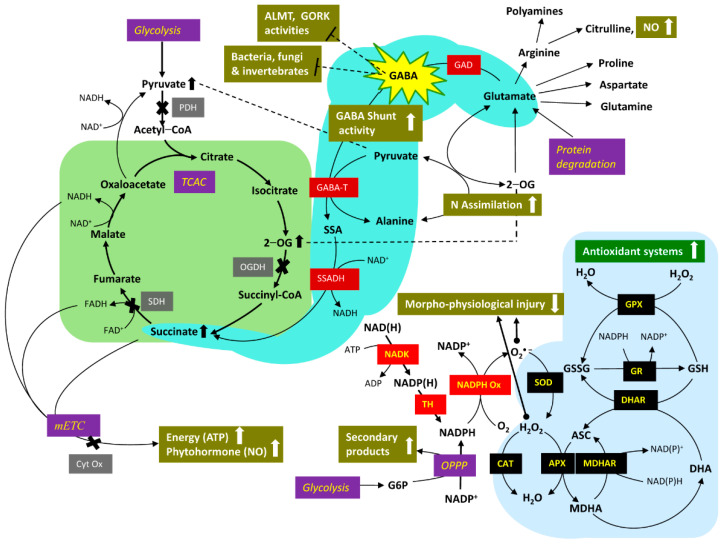Figure 2.
Abiotic and biotic stress-induced changes in morphological and physiological features are restored or partially restored by increasing endogenous GABA and GABA shunt activity. Depending upon the nature of the abiotic stress, the entry of pyruvate into the tricarboxylic acid cycle via pyruvate dehydrogenase, the catabolism of 2−oxoglutarate and succinate via 2−oxoglutarate dehydrogenase and succinate dehydrogenase, respectively, and activity of cytochrome oxidase in the mitochondrial electron transport chain may be restricted, thereby limiting the generation of molecules associated with energy transfer (NADH, FADH and ATP). These limitations are to some extent overcome by increasing the levels of endogenous GABA, by either GAD overexpression or application of exogenous GABA. The elevated endogenous GABA increases flux through the shunt, which in turn, increases the level and/or entry of succinate into the non−cyclic tricarboxylic acid cycle, mitochondrial electron transport chain, and accordingly, ATP generation. The elevated GABA also modifies the activity of stress-induced pathways involving enzymatic and non−enzymatic antioxidants, N assimilation, secondary products, and phytohormones (NO; ethylene and ABA are not shown) by uncharacterized mechanisms. The activity of phytopathogens is directly inhibited by accumulated GABA. Symbols: X, biochemical reaction potentially inhibited by stress; white filled arrows, increasing or decreasing activity of pathway(s) affected by GABA; black filled arrow, increasing level of metabolite affected by stress. Abbreviations: ALMT, aluminum−activated malate transporter; Cyt Ox, cytochrome oxidase; NADK, NAD kinase; OPPP, oxidative pentose phosphate pathway; PDH, pyruvate dehydrogenase; SAM, S−adenosylmethionine; SDH, succinate dehydrogenase; TCAC, tricarboxylic acid cycle; TH, transhydrogenase; see Table 4 legend for the remaining abbreviations.

